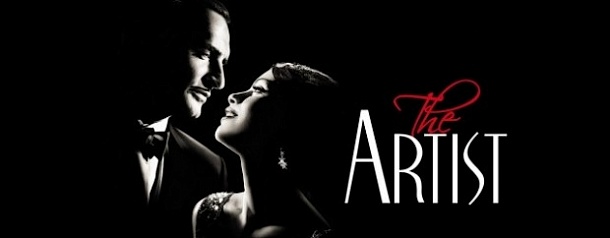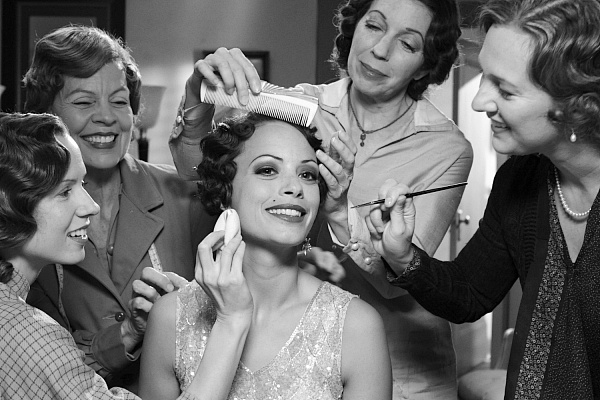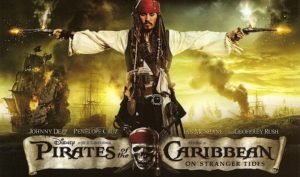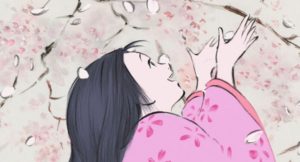“I won’t talk. I won’t say a word.” These are the first words we read from the intertitle card of George Valentin’s film A Russian Affair. We then realise that we’re actually watching people, watching a film, in an auditorium. How quaint. Not only is Michel Hazanavicius’ The Artist loaded with symbolism and subtext; it happens to be a black and white film with no dialogue. Hell, it’s not even in widescreen!
Set in 1927, silent movie star George Valentin (Jean Dujardin) is at the top of his game with his latest film, A Russian Affair, set to be a huge hit. At the premiere he poses for pictures and meets a fan, Peppy Miller (Bérénice Bejo). She also happens to be an aspiring actress and manages to land a role in Valentin’s follow up film. However, come the advent of sound and the head of Kinograph Studios, Al Zimmer (John Goodman), shows his leading man the future of talking pictures. Valentin laughs at the prospect, believing that it’ll never take off. Sticking with silent films, Valentin’s career declines while Peppy’s ascends dramatically, going from playing bit parts to headlining films.
Sharing obvious similarities with Singing in the Rain and A Star is Born, if those two films ever got jiggy together then The Artist would be their gifted love child with selective mutism. While the ‘back in time’ technique may have raised interest, a silent modern-day monochrome is nothing new. 2007’s sci-fi drama La Antena also employed the same practice, and the fact that it is ‘mostly’ silent is actually an ingenious plot point. The Artist similarly gives its audience the silent treatment, which may appear gimmicky at first, but feels appropriate given the story and setting, bringing the audience into Valentin’s world and his dilemma as he struggles to find his place in Hollywood.
The story is simple enough, but it’s the lead performances from Jean Dujardin and Bérénice Bejo that carry the film, with facial expressions and body movements saying more than any words can (and to an extent, even the costumes). Dujardin in particular admits to drawing inspiration from Douglas Fairbanks, and ended up winning Best Actor at the film’s premiere at Cannes. His character Valentin stars, directs and produces his own silent film, Tears of Love, which is unfortunately released during the Wall Street Crash of 1929. After Valentin’s chauffeur, Clifton (James Cromwell), brings him the news of the crash, his response is that they ought to be fine should the film be a success, but the lack of optimism on his face tells us all we need to know. Valentin stands at the back of a largely vacant cinema showing his film. Not only is it a sign of things to come, (later he’s standing at the back of a largely empty auction house), but what he sees upon leaving the cinema is enough to destroy him. His Jack Russell terrier Uggy is also worthy of praise, and is surprisingly even allowed into cinemas to watch films.
Valentin’s relationship with Peppy is an unusual one, for despite his initial attraction, her eventual rise in popularity means he’s reluctant to call her or be in her presence and later shows little interest when she offers to help him. It’s heartbreaking to see him treat his love as his rival, for ultimately, how can you bring yourself close to someone when they’ve had a hand in your downfall?
While there are no qualms with Dujardin’s performance, it’s the stubborn nature of his character that brings about a minor moan. Too proud to admit that he was wrong, Valentin may have found resolution at the end, but he hasn’t really progressed. Before then, he does suffer a rather rapid decline. His wife Doris (Penelope Ann Miller) makes fun of him, sketching over his magazine and newspaper photos. She really rubs it in by recommending that he watch Peppy’s “incredible” new film Beauty Spot. Contributing to The Artist’s playful self-awareness, when confronting Valentin about their collapsed marriage, she tells him, “We have to talk.” The subtext is as clear as Technicolor.
In keeping with the style there is a musical score, and it’s ‘mostly’ the only thing you’ll hear throughout the film. A lot of pressure comes upon composer Ludovic Bource, yet his score turns out to be just as much a character, and is also slightly foreboding at times. The film is actually in Dolby Digital, though the majority of the sound is relegated to the front. The rear speakers only kick into life once, when Valentin has a noisy dream. Also, if you can lip-read you’ll be able to pick up little in-jokes that the intertitles miss.
The Artist is an absolute joy. A tribute to the Hollywood that has been lost for decades, our memory of which only survives via the strength of celluloid. As a love letter to cinema, it might even make you revisit those old classics. Having recently picked up a clutch of Golden Globe nominations, it’s highly likely to lead the pack come Oscar time. It’s not often that you find a blissfully emotive movie-going experience and that alone should be reason enough to go see The Artist.
The Artist opens at Vue West End on December 30th and across the UK on January 6th.
Originally published on MCM Buzz on 24 December 2011.





